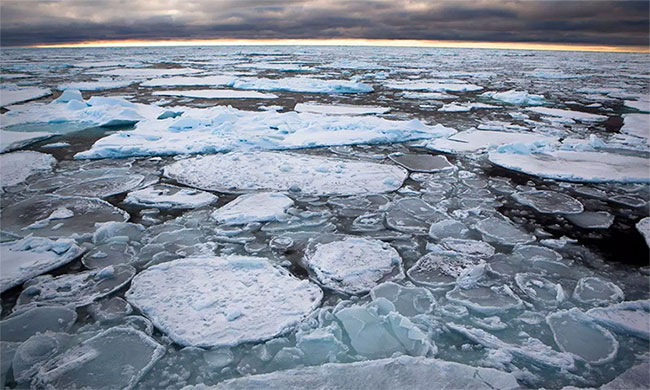Huge warm water tank is
The Arctic ice sheet is not only melting because of climate change but is also affected by a giant warm water pool formed below the icy north of Canada.
New research published by Yale University and Woods Hole Oceanographic Institute (USA) has partly explained why the Arctic warms twice as fast as the average rate of global warming. The data collected during 30 years showed that a mysterious local heat source had impacted this freezing zone.
It is an underground warm water tank , created by climate change and then back to exacerbate the harmful effects of climate change.

The Arctic is heating up at twice the average speed of global warming - (photo: THE GUARDIAN).
This warm water comes from a special stream of water, flowing south to Chukchi waters, which is warmer and no longer a sea ice like many years ago. Therefore, the water flow is exposed to the sun and is heated.
After being warmed up, these countries get the Arctic winds blowing back to the north, bunching up into an underground warm water pool stuck beneath the ice of the North Pole. This warm water is the top layer of water so it can melt ice quickly.
"The icy loss not only affects the regions directly melting, but also leads to the accumulation of heat inside the more polar regions of the Arctic Ocean" - head of the professor Mary-Louise Timmermans. study, say.
It is estimated that the warm water pool trapped under the Arctic ice is now hundreds of miles wide. If the country continues to affect the surface ice, it is fully capable of completely melting the frozen ice of the Arctic Ocean, causing great devastation to the ecosystem and the life of the people in this area. .
Earlier this year, almost all of the ice covering the Bering Sea in the North Pacific disappeared for months, affecting fishing by residents of Western Alaska (USA). In the past year, images of skinny, polar bear bears struggling in the heat have also caused global shaking.
The research has just been published in the Science Advances journal.
- This simple idea has saved tens of thousands of poor Africans
- Avo - The fish tank for busy people
- Africa lies on a huge underground water tank
- The reason you should drink warm water instead of cold water
- Water bottles help the owner prevent dehydration
- Uses of the water tower
- Ancient medicine confirms that cold water is more harmful to the body than warm water
- Israel discovered 2,700 years of underground water tank
- 1000 degree C water tank under Bolivia volcano
- Water tank and armor plates of American soldiers: quench, cool, use ice to increase the bulletproof
- To what extent is lead sludge spilled into dangerous rivers?
- The remains of the water tank reveal the collective beheading of the ancient book
 Is the magnetic North Pole shift dangerous to humanity?
Is the magnetic North Pole shift dangerous to humanity? Washington legalizes the recycling of human bodies into fertilizer
Washington legalizes the recycling of human bodies into fertilizer Lightning stone - the mysterious guest
Lightning stone - the mysterious guest Stunned by the mysterious sunset, strange appearance
Stunned by the mysterious sunset, strange appearance